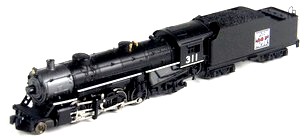|
| Z
Scale is set apart from the larger modelling scales not only by its tiny size
(models are scaled at 1:220) but also by a number of
idiosyncrasies which have characterized Z Scale for most
of the first 50 years of its existence. |
| |
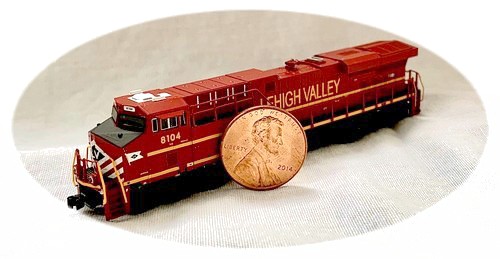
|
|
Introduced
in 1972 by long-established toy and model trains
maker Märklin of Germany as "the smallest
model railway system in the world", the
launch came with a complete range covering track,
rolling stock, structures and accessories - all
provided by Märklin.
Z Scale operates on 8-10V DC with
an overall track footprint over ties measuring
only half an inch (12.4 mm) for a single line of
straight track.
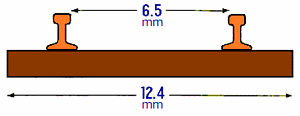
|
|
| |
| And a
double track line only takes up 1.4 inches (36 mm) in
width, or 1.6 inches (40 mm) when using track with a
permanent plastic roadbed base imitating ballast. |
| |
 |
| |
| Being only 72% the size of N Scale (and a
mere 40% of HO Scale), Z Scale requires substantially
less space than other modelling scales. |
| |
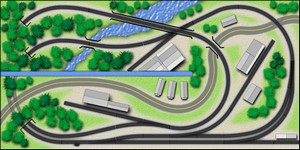
Grey River Northern Trackplan (c) David K. Smith
|
|
As
a result, the rather complex trackplan shown here
has a footprint of only 24"x48" (60x120 cm) in Z Scale yet
offers continuous running (even twice around)
along with several spurs and the potential to
model scenic variety. Reliable continuous running with medium and larger
locomotive on a full
circle of track is even possible
in as little space as 20"x20" (50x50 cm); tight curves
will even find sufficient space within the
confines of a briefcase, and short rolling stock
will run flawlessly on such a micro track layout. But Z
Scale was essentially launched to be Märklin's
very own and exclusive model railway range, and
for a very long time did remain a single
manufacturer product range.
|
|
| |
In
promoting Z Scale, Märklin always emphasized the smallness of the models:
"[Z
scale] opens up new possibilities for
operating electric model railroads in the
smallest possible space." (Introduction,
1986/87 Märklin Z Scale Catalogue)
Over
the next few decades, the models became more
advanced and intricate, leading Märklin to focus
more on the engineering precision involved when
celebrating 50 years of Z Scale in 2022:
"[Z
Scale offers] perfection in the scale of
1:220 (...) it has affectionately been called
"Mini-Club" too for decades as a
symbol for exclusive fine mechanics in
railroad model building. What came out (...)
in 1972 with plastic wheels and a lifestyle
image has grown into a full-fledged model
train system." (Märklin 2022 General
Catalogue)
|
|
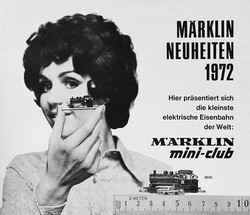
|
|
| |
| Nonetheless,
Z Scale couldn't generate any substantial interest in
other major manufacturers (quite unlike N Scale), and
Märklin seemed quite happy to have the market (that they
themselves created) cornered. |
| |
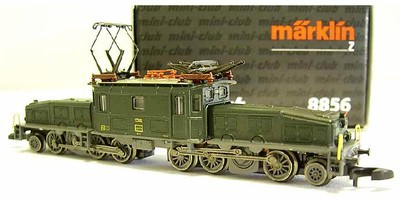 |
|
With
regard to European rail prototypes and the
European market, Märklin (who introduced their
first non-German Z scale locomotive, the Swiss
"Crocodile", in 1979) has therefore
pretty much managed to preserve its exclusive
standing for Z Scale right to this day. In spite
of a few small enterprises offering accessories
and even rolling stock, there is no serious
challenge to Märklin's market dominance to speak
of. Whilst this has clearly
prevented Z Scale from becoming as popular and
widespread as N Scale and forced it to remain a
niche interest, the
story of Z Scale followed a decidedly different
course of events with regard to North American
and Japanese rail prototypes,
|
|
| |
| |
 |
AMERICAN
Z SCALE
|
 |
| |
| Märklin essentially aimed Z
Scale at its traditional and fairly large German home
market and only gradually added models based on
non-German locomotives and rolling stock during the 1980s
- but the scope of "foreign models" remained
very limited. This didn't mean, however, that people
outside Germany weren't taking notice of Z Scale, and one
individual taking a very pronounced interest was Nelson Gray (1916-2017). He had been scratchbuiling
items for his own model railroading needs since High
School, decided to explore the possibilities of creating
US prototype Z Scale items, and eventually offered a
range of highly detailed freight cars and an F7A diesel
locomotive out of his small workshop in Syracuse, NY in
1978.
|
| |
| Gray's
complete line of Z Scale tooling was acquired in
1982 by Micro-Trains (still operating under the
name of Kadee at the time), who released their
first Z Scale items in late 1984, consisting of a
F7A diesel locomotive (initially in Pennsylvania
and Western Pacific colours), a 40' gondola, a
40' flat car, a 40' wood-sheathed box car, a
bulk-end flat car, a 40' livestock car, a 50'
rib-side boxcar and a center-cupola caboose. By a
strange twist of coincidence, Märklin not only entered the US
market in 1984 as well, but they did so with the
very same Z Scale model - the F7A diesel, albeit
available in three different paint schemes than those initially
offered by Micro-Trains (Amtrak, Santa Fe Red
Warbonnet and Southern Pacific Black
Widow). The Märklin locomotives were
accompanied by a 50'
box car, a 45' gondola and a Santa Fe style
caboose. Where Märklin did manage to set itself
apart from Micro-Trains was with the launch of no
less than six different body style passenger cars
in AMTRAK livery to go with the F7: baggage,
coach, diner, sleeper, dome and observation.
|
|
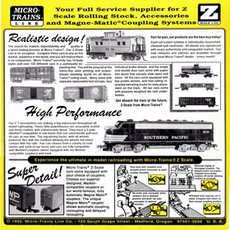 |
|
| |

 |
|
This
first batch of Märklin models was followed in
late 1984 by a Chessie freight train
set
which consisted of a Chessie F7 with three
matching blue boxcars (lettered for the Chessie
railroads C&O, B&O, and WM) and a yellow
caboose, whilst Micro-trains added Southern
Pacific and Lehigh Valley to its selection of
paint schemes. On the surface of
things, the offerings of the two companies looked
very similar - but the differences were actually
quite pronounced as far as the individual models
were concerned. Whilst Märklin stretched the F7
body to fit an already available chassis from a
German prototype model, Gray's original tooling
produced a fairly accurately scaled model.
|
|
| |
| Following an extended period of
non-existence in Z Scale, US prototype modelling was
suddenly here with a bang, and in April 1985 Model Railroader
announced that "Z Scale has arrived!"
- which not only was the title of that issue's editorial
but also the general tone set by an in-depth introduction
to the scale ("Some ABCs of Z Scale")
and a staff layout project. |
| |

|
| |
| Editor
Russ Larson saw what he believed to be the real beginning
of Z Scale as a major modelling scale in North America,
and this enthusiasm was mirrored in a featured layout
project, aimed at showing just what could be done in Z
scale in what little space. |
| |
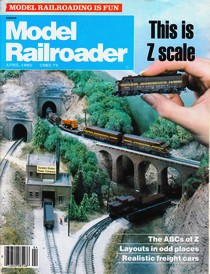 |
|
And
the Pennsylvania & Pacific certainly
packed a lot of model railroading and
inspirational allure into a mere 2'x3' (60x90cm).
"What's
the future for Z scale? I think it can be
very good. If Märklin is able to sustain its
promotional efforts (...) I think it could
even give N scale a run for second place in
popularity in the next 5 years." (Editorial, April
1985 Model Railroader)
The momentum
was there, but the promises for the future evoked
by Model Railroader did not match up
well with the fact that no major new
manufacturers stepped into the scale.
Model
Railroader highlighted Z Scale for a second
time in its February and March 1986 issues with a
larger size modular layout based on the Western
Pacific's Feather Canyon route. But the fact that
Micro-Trains and Märklin were still the sole
major suppliers, and the F7 still the only ready
to run motive power available, essentially only
served to show that Z Scale hadn't moved on and
was essentially a modelling niche. Not
surprisingly, Z Scale would not feature in Model
Railroader again for many years to come -
not the least because for an extended period of
time, nothing moved in Z Scale.
|
|
| |
| Attempts
to produce ready-to-run models of other US diesels were
made during the 1990s, but the road was long and winding. |
| |
| A GP38-2
was introduced by Rogue
Locomotive Works (founded in 1997
as Small Scale Works), but the
very first hood unit in Z scale
encountered various production
problems, and in the end only a
very limited number of these
locomotives actually reached the
market and Z Scale layouts. But it
was a start, and RLW's tool-maker
Don Bouchard proved, above all,
to the Z scale community as well
as to its suppliers at large
that, yes, it could be done. And
indeed, things began to move as
the new millenium settled in.
|
|
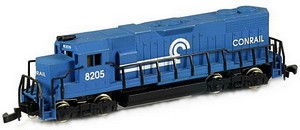
|
|
|
|
| |
| Initially,
however, this only applied to the upper end of the scale
as American Z Lines AZL (born from the ashes of
RLW) introduced a stunning brass C44-9W in September 2000. Manufactured by
Ajin in Korea in fairly small numbers (500 per one of eight roadnames),
their price at the time (USD 550.00) was actually
affordable in comparison to brass model imports in larger
scales, yet obviously still put them outside the regular
ready-to-run market. |
| |
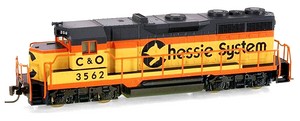
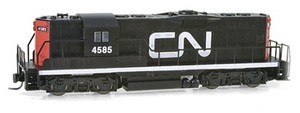
|
|
For
a couple of years AZL continued to fill the void
with select brass models (such as the PA and E8),
but the scale as a whole did not receive any true
overall boost from these models. It wasn't until Micro-Trains and AZL introduced
plastic injection models that Z Scale awoke from
its general lethargy. MT launched its GP35 in 2006, followed
only a few months later by AZL's GP7, which in turn saw MT's
GP9 (seen here below the GP35) hot on its heels
in early 2007, joined by an SD40-2 (also from
Micro-Trains) in 2009.
In a flash Z Scale had gone from being a
one horse town to actually offering modellers
various choices in the motive power division.
Unlike
in previous years, Z Scale now kept the momentum
and stayed moving - and in 2012/13 there was
almost an explosion of new motive power.
|
|
| |
| AZL launched its
GP38-2, an improved version of
the old RLW model with closer to
scale handrails and horns (the
body shell still has ROGUE stamped on the
inside) as a competitively priced
entry-level model. It is now
available in many roadnames and
paint schemes. In addition to
this diesel, AZL somewhat dipped
into their past by launching a
high-end limited run brass model
of UP's Big Boy 4-8-8-4 steam
colossus (providing, if nothing
else, a good "talking
point" for Z Scale), but
fortunately this was also joined
by a plastic injection Mikado
2-8-2.
|
|
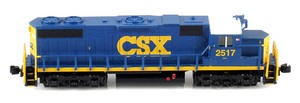
|
|
|
|
|
| The introduction
of heavyweight passenger coaches
(AZL) as well as a multitude of
freight models from smaller
companies (e.g. Full Throttle) has further
enhanced the choice available in
Z Scale. New freight car
types were also introduced
regularly by AZL, with monthly
repaints on existing models
(including the F7A and B between
2013 and 2017) coming from
Micro-Trains as well.
|
|
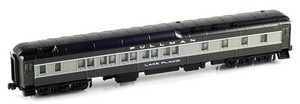
|
|
|
|
| |
| Since 2013,
AZL has released more and more models of both locomotives
and rolling stock, to the degree where they clearly are
the market driver for North American Z Scale. |
| |
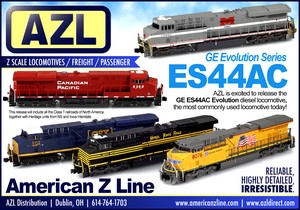
|
|
Today, AZL offers
an amazing range of locomotives
(ranging from steam engines to
both first generation and modern
diesel locomotives) and rolling
stock, with a wide variety of
railroads and paint jobs to boot
(although the specifics of the
still small Z Scale market result
in items being sold out either
very quickly or over time, and
once that happens, re-releases
are the exception). 
|
|
|
|
| |
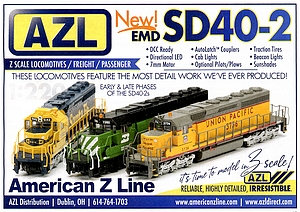
|
|
AZL continues to
expand its range of Z Scale
models twice every month, with
new types of locomotives and
rolling stock introduced at
regular intervals. The company
has also increased its marketing
reach, with advertisements in
magazines such as Model
Railroader providing more
visibility for Z Scale - or, as
AZL's slogan has it: "it's
time to model in Z scale!". Micro-Trains, on
the other hand, have effectively
dropped their Z Scale locomotives
and now focusses on (pleasing)
repaints of existing rolling
stock.
Well-known
manufacturer Atlas entered the
market with their flextrack and
points in 2019, and increased its
footprint in Z Scale with the
release of a set of modern
boxcars in 2024.
|
|
|
|
| |
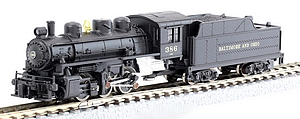
|
|
Also in 2024,
Rokuhan (best known for their Z
Scale track) released their first
US prototype locomotive, a
Baltimore & Ohio USRA 0-6-0
steam switcher, adding even more
choices from more manufacturers. It is a stark and
pleasant contrast to days gone
by, when the small
size of Z scale was mirrored by
an equally tiny selection of
models, track and accessories. In
addition, both track and wheel
standards of any Z scale model
these days are at least equal to
those of larger scales, and the
advent of 3D-printing has further
increased available options.
|
|
|
|
| |
| |
 |
|
 |
| |
| Given the
traditionally strong position of smaller modelling scales
(especially N Scale) in Japan it is perhaps somewhat
surprising that Z Scale does not have as long a history
in Japan as it does in Europe and the US. |
| |
| The first
Japanese Z Scale models were
introduced along with a limited
range of sectional track in 2006
by a company named RealZJ (which
is still active today but now
known as Crown). In 2007 Tokyo
Mauri launched its ProZ range,
and since then a number of
different manufacturers
(including well-known names such
as Tenshodo) have added to the
offerings, which are all
exclusively Japanese prototype
models. Whilst gradually building
up a Z scale market, the impact
has been very much limited to
Japan itself. Quite the opposite
is true with regard to the
product range offered by Rokuhan, who entered the
market in 2008.
|
|
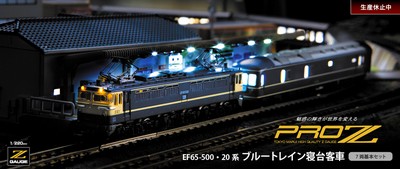
|
|
|
|
| |
| The
fundamental difference was that Rokuhan concentrated on a
complete track and controls system which quickly extended
even beyond the established Märklin track geometry. |
| |
 |
|
Including a moulded ballast base
the track looks very much like a smaller cousin
of Kato's Unitrack - a reference
explicitly made when the German specialist
company NOCH started distributing the track system in Europe in early 2011.
Rokuhan
thus very quickly established itself as the go-to
manufacturer for Z scale track, even successfully
challenging Märklin on its home turf market.
|
|
| |
| Rokuhan has since
built up an amazing range of
controllers and structures
(including various bridges,
buildings as well as a turntable)
which since 2013 is complemented
by a growing selection of motive
power and rolling stock - as well
as the all-important starter sets
that provide an easy access and
entry to the scale. The models are
all of Japanese prototype, a
clear indication that Rokuhan is
seeing its home market as its
true base. However, by virtue of
its (still expanding) track
system and range of controllers
(which can be operated both on
batteries and mains power),
Rokuhan has had a major impact on
Z Scale in Europe and the US and
continues to do so.
The company also
maintains a presence in social
media, including a YouTube channel where new items
are presented in video form in
addition to their website.
|
|
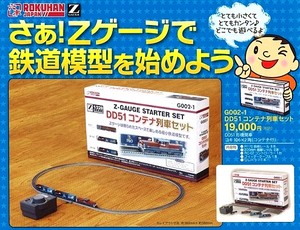
|
|
|
|
| |
| |
|
| |
Any
commercial products or companies mentioned here are
purely bona fide indications of what I have been using
myself.
I have no connection to any manufacturing companies nor
do I profit from listing any products or brands.
|
| |
American Z Line AZL
US manufacturer who specializes exclusively in Z
scale locomotives and rolling stockFull Throttle
William Dean Wright specializes exclusively in Z
scale rolling stock, trucks and wheelsets
Märklin
Z Scale pages from the original creator of Z
Scale (in German, English menu)
Micro-Trains
US Manufacturer of Z scale locomotives, rolling
stock, track and accessories
Rokuhan
Japanese manufacturer who specializes
exclusively in Z scale locomotives, rolling stock, track,
controlers and accessories
Trainboard Z Scale Forum
Message board for Z Scale enthusiasts, lots of
news, pictures and projects
Z Scale layouts &
track plans @ RailServe.com
A comprehensive listing of Z Scale layouts and websites
(including a few dead links but well worth the visit)
Z Central Station
Meeting place for Z Scale enthusiasts, with
news, pictures and message boards
Ztrack Magazine
The magazine for Z Scale model railroading
|
| |
|
| |


    
BACK TO MAIN INDEX PAGE

(c) 2012-2024
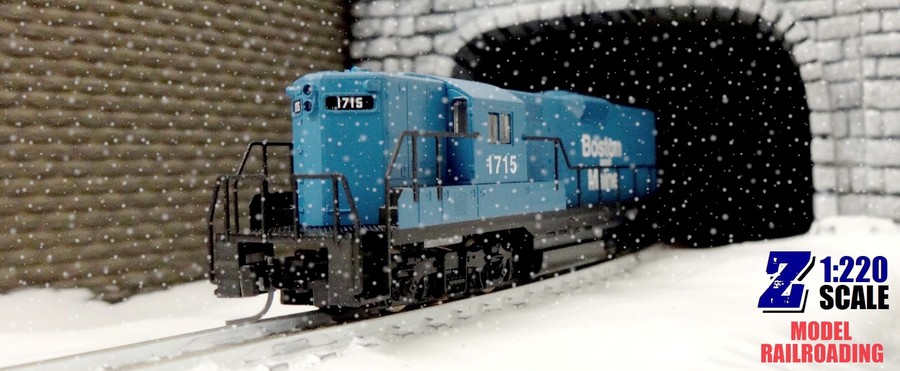
|
page
created 3 April 2012
page updated 26 September 2024
|

















